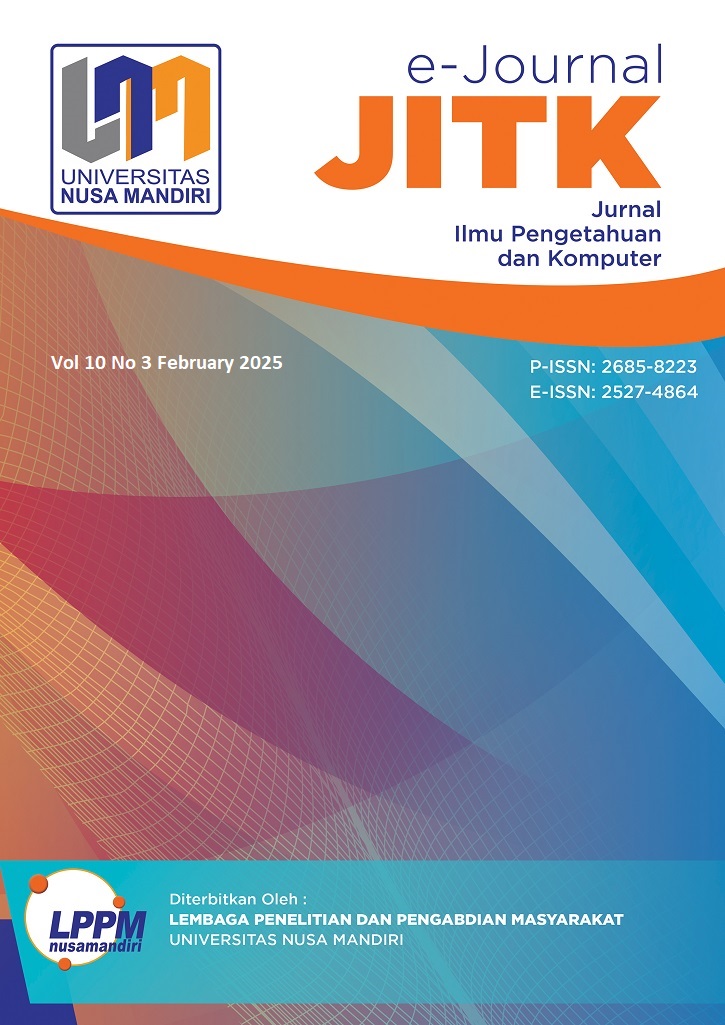DENTAL CARIES SEVERITY DETECTION WITH A COMBINATION OF INTRAORAL IMAGES AND BITEWING RADIOGRAPHS
DOI:
https://doi.org/10.33480/jitk.v10i3.6042Keywords:
bitewing radiograph, caries, deep learning, intraoral imageAbstract
Dental caries is a multifactorial oral disease caused by plaque due to bacterial sugar fermentation. Quite a number of dentists have misdiagnosed caries due to the subjective nature of visual examination and radiograph in early-stage lesions. Thus, research on the implementation of deep learning technology is expected to improve the accuracy of diagnosis. However, caries detection with deep learning has accuracy problems. This problem makes researchers interested in developing a deep learning method that combines Faster R-CNN algorithm and texture feature extraction to more accurately detect carious teeth from bitewing radiography datasets and intraoral images. The overall performance of the model to detect the radiographic class was slightly better than the intraoral class. Overall, the classification accuracy of the model was 88.95% which is better than previous research that only used one or the other type of images. GLCM (Gray-Level Co-Occurrence Matrix) is effective in detecting contrast areas, but it still cannot specifically distinguish normal anatomical contrast from caries. The Faster R-CNN model learned well and was able to differentiate between each caries type and was successfully integrated with the GLCM matrix for radiographic image pre-processing to facilitate caries detection. This approach could have the potential of assisting dental professionals in reducing diagnostic errors and increasing patient care.
Downloads
References
Riskesdas, “Laporan Riskesdas 2018 Nasional,” Jakarta, 2018.
N. S. Wahyuni, “Apa Itu Karies Gigi.” Accessed: May 09, 2024. [Online]. Available: https://yankes.kemkes.go.id/view_artikel/1383/apa-itu-karies-gigi.
WHO, “Global oral health status report: towards universal health coverage for oral health by 2030,” 2022. [Online]. Available: http://apps.who.int/bookorders.
F. Meyer, E. Schulze Zur Wiesche, B. T. Amaechi, H. Limeback, and J. Enax, “Caries Etiology and Preventive Measures,” 2024, Georg Thieme Verlag. doi: 10.1055/s-0043-1777051.
T. M. . Roberson, Harald. Heymann, E. J. . Swift, and C. M. . Sturdevant, Sturdevant’s art and science of operative dentistry, 7th ed. Missouri: Elsevier, 2019.
R. A. Sharif, S. Chaturvedi, G. Suleman, A. E. Elmahdi, and M. F. A. Elagib, “Analysis of tooth extraction causes and patterns,” Open Access Maced J Med Sci, vol. 8, no. D, pp. 36–41, 2020, doi: 10.3889/OAMJMS.2020.3784.
Oxford University Press, Oxford Advanced Learner’s Dictionary, 10th ed. Oxford, 2023.
A. Daniels et al., “CROSS-SECTIONAL STUDY Clinical Versus Radiographic Caries Diagnosis in Primary Tooth Approximal Surfaces,” PediatricDentistry, vol. 3, no. 42, pp. 193–196, 2020.
W. Li, “Analysis of Object Detection Performance Based on Faster R-CNN,” J Phys Conf Ser, vol. 1827, no. 1, pp. 1–10, Mar. 2021, doi: 10.1088/1742-6596/1827/1/012085.
K. Yoon, H.-M. Jeong, J.-W. Kim, J.-H. Park, and J. Choi, “AI-based dental caries and tooth number detection in intraoral photos: Model development and performance evaluation,” J Dent, vol. 141, 2024, doi: https://doi.org/10.1016/j.jdent.2023.104821.
A. Fariza, R. Asmara, M. O. F. Rojaby, E. R. Astuti, and R. H. Putra, “Evaluation of Convolutional Neural Network for Automatic Caries Detection in Digital Radiograph Panoramic on Small Dataset,” Proceedings of 2022 International Conference on Data and Software Engineering, ICoDSE, pp. 65–70, 2022, doi: 10.1109/ICoDSE56892.2022.9972183.
S. Anil, P. Porwal, and A. Porwal, “Transforming Dental Caries Diagnosis Through Artificial Intelligence-Based Techniques,” Cureus, Jul. 2023, doi: 10.7759/cureus.41694.
A. Juyal, H. Tiwari, U. K. Singh, N. Kumar, and S. Kumar, “Dental Caries Detection Using Faster R-CNN and YOLO V3,” ITM Web of Conferences, vol. 53, no. 02005, pp. 1–16, 2023, doi: 10.1051/itmconf/20235302005.
A. G. Cantu et al., “Detecting caries lesions of different radiographic extension on bitewings using deep learning,” J Dent, vol. 100, p. 1, Sep. 2020, doi: 10.1016/j.jdent.2020.103425.
N. Ammar and J. Kühnisch, “Diagnostic performance of artificial intelligence-aided caries detection on bitewing radiographs: a systematic review and meta-analysis,” Japanese Dental Science Review, vol. 60, pp. 128–136, Dec. 2024, doi: 10.1016/j.jdsr.2024.02.001.
S. Anil, K. Sudeep, S. Saratchandran, and V. K. Sweety, “Revolutionizing Dental Caries Diagnosis through Artificial Intelligence,” IntechOpen, pp. 1–27, 2023, doi: DOI: http://dx.doi.org/10.5772/intechopen.112979.
O. Fejerskov, B. Nyvad, and E. Kidd, Dental Caries : The disease and its clinical management, 4th ed. Chichester: Wiley-Blackwell, 2024.
F. Litzenburger, G. Schäfer, R. Hickel, J. Kühnisch, and K. Heck, “Comparison of novel and established caries diagnostic methods: a clinical study on occlusal surfaces,” BMC Oral Health, vol. 21, no. 97, pp. 1–10, Mar. 2021, doi: 10.1186/s12903-021-01465-8.
H. Mohammad-Rahimi, S. R. Motamedia, and M. H. Rohban, “Deep learning for caries detection: A systematic review,” JDent, no. 122, pp. 1–16, 2022, doi: doi:10.1016/j.dent.2022.104115.
G. M. S. Himel, M. M. Islam, and U. H. Hannan, “Caries-Spectra: A dataset of Enamel Caries,” 2023. doi: 10.17632/9jnf2jvghy.2.
J. Kybic, A. Tichý, and L. Kunt, “Dental caries in bitewing radiographs,” 2023. doi: 10.17632/4fbdxs7s7w.1.
W. Wang, Y. Hu, T. Zou, H. Liu, J. Wang, and X. Wang, “A New Image Classification Approach via Improved MobileNet Models with Local Receptive Field Expansion in Shallow Layers,” Hindawi Computational Intelligence and Neuroscience, pp. 1–10, 2020, doi: 10.1155/2020/8817849.
J. Chen et al., “Run, Don’t Walk: Chasing Higher FLOPS for Faster Neural Networks,” 2023.
R. Obuchowicz, K. Nurzynska, B. Obuchowicz, A. Urbanik, and A. Piórkowski, “Caries detection enhancement using texture feature maps of intraoral radiographs,” Oral Radiol, vol. 36, no. 3, pp. 275–287, Jul. 2020, doi: 10.1007/s11282-018-0354-8.
E. Whaites and N. Drage, Essentials of dental radiography and radiology, 6th ed. Elsevier Health Sciences, 2020.
A. Sabharwal, N. Kavthekar, J. Miecznikowski, M. Glogauer, A. Maddi, and P. Sarder, “Integrating Image Analysis and Dental Radiography for Periodontal and Peri-Implant Diagnosis,” 2022, Frontiers Media S.A. doi: 10.3389/fdmed.2022.840963.
H. Mohammed, A. Tannouche, and Y. Ounejjar, “Weed Detection in Pea Cultivation with the Faster RCNN ResNet 50 Convolutional Neural Network,” Revue d’Intelligence Artificielle, vol. 36, no. 1, pp. 13–18, Feb. 2022, doi: 10.18280/ria.360102.
Downloads
Published
How to Cite
Issue
Section
License
Copyright (c) 2025 Jennifer Jennifer, Winni Setiawati, Gabriella Adeline Halim, Tony Tony

This work is licensed under a Creative Commons Attribution-NonCommercial 4.0 International License.











-a.jpg)
-b.jpg)














